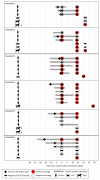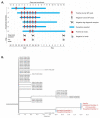One Health Investigation of SARS-CoV-2 Infection and Seropositivity among Pets in Households with Confirmed Human COVID-19 Cases-Utah and Wisconsin, 2020
- PMID: 34578394
- PMCID: PMC8472995
- DOI: 10.3390/v13091813
One Health Investigation of SARS-CoV-2 Infection and Seropositivity among Pets in Households with Confirmed Human COVID-19 Cases-Utah and Wisconsin, 2020
Abstract
Approximately 67% of U.S. households have pets. Limited data are available on SARS-CoV-2 in pets. We assessed SARS-CoV-2 infection in pets during a COVID-19 household transmission investigation. Pets from households with ≥1 person with laboratory-confirmed COVID-19 were eligible for inclusion from April-May 2020. We enrolled 37 dogs and 19 cats from 34 households. All oropharyngeal, nasal, and rectal swabs tested negative by rRT-PCR; one dog's fur swabs (2%) tested positive by rRT-PCR at the first sampling. Among 47 pets with serological results, eight (17%) pets (four dogs, four cats) from 6/30 (20%) households had detectable SARS-CoV-2 neutralizing antibodies. In households with a seropositive pet, the proportion of people with laboratory-confirmed COVID-19 was greater (median 79%; range: 40-100%) compared to households with no seropositive pet (median 37%; range: 13-100%) (p = 0.01). Thirty-three pets with serologic results had frequent daily contact (≥1 h) with the index patient before the person's COVID-19 diagnosis. Of these 33 pets, 14 (42%) had decreased contact with the index patient after diagnosis and none were seropositive; of the 19 (58%) pets with continued contact, four (21%) were seropositive. Seropositive pets likely acquired infection after contact with people with COVID-19. People with COVID-19 should restrict contact with pets and other animals.
Keywords: COVID-19; SARS-CoV-2; cat; dog; household transmission; pets; transmission; zoonoses.
Conflict of interest statement
The authors declare no conflict of interest.
Figures



References
-
- American Pet Products Association . 2019–2020 Appa National Pet Owners Survey. American Pet Products Association; Stamford, CT, USA: 2019.
-
- Duncan S.L., Allen K.J.H. Handbook on Animal-Assisted Therapy: Theoretical Foundations and Guidelines for Practice. Acadmic Press; San Diego, CA, USA: 2000. Service animals and their roles in enhancing independence, quality of life, and employment for people with disabilities; pp. 303–323.
Publication types
MeSH terms
Substances
LinkOut - more resources
Full Text Sources
Medical
Miscellaneous

